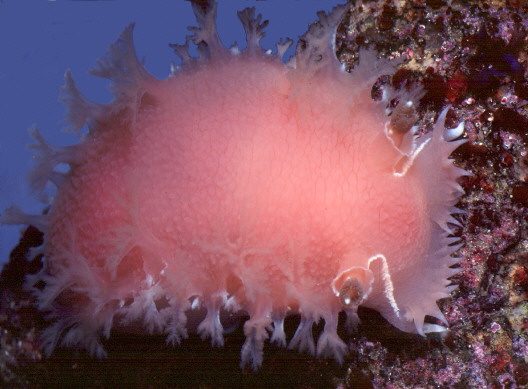
Tritonia diomedea
Tritonia diomedea Bergh 1894
The nudibranch gastropod Tritonia diomedea Bergh (1894) inhabits subtidal waters (5-750 m) in the northern Pacific Ocean [Japan to Panama?] (Bergh 1894, McDonald 1983, MacFarland 1966). It feeds on pennatulacean cnidarians- Ptilosarcus gurneyi, Virgularia, and Stylatula elongata in Washington and British Columbian waters, and Acanthoptilum in Californian waters as deep as 200 m. T. diomedea will also feed on the Californian sea pansy Renilla köllikeri in the laboratory although it is unknown if they do so in nature. It appears that in many cases a geographically isolated group of Tritonia will eat only one prey species, and this prey species varies between groups. T. diomedea lives among beds of these soft corals on flat or gently sloping soft bottoms of sand or silt.
T. diomedea found among Virgularia tend to be smaller (0.5-20 cm) than those found among Ptilosarcus (8-30 cm). To my knowledge, no Tritonia diomedea under 5 cm has ever been found in a Ptilosarcus bed, although it metamorphoses from a veliger larva into a slug ~1 mm long. Whether smaller slugs are difficult to locate, or are migrating from elsewhere after growing is unknown. Those found among Ptilosarcus tend to be orange (like Ptilosarcus), with distinct tubercles on the dorsum, while those found among Virgularia tend to be redder in hue, from brick red to pale pink, and have a smoother dorsum (MacFarland 1966 for color illustration). It is unknown whether these two forms are genetically distinct, but the two forms will mate and do produce motile veligers.
T. diomedea can grow to 30 cm in length and to a mass of 1700 g (Willows 1967b). Given laboratory growth rates, a slug would require 1265 days to reach 1700 g. One slug raised in the laboratory lived for 1.5 years (Willows personal communication). The congeners T. festiva and T. hombergi are considerably smaller than the largest T. diomedea and apparently live only one year (Thompson 1962).
T. diomedea is often found with a characteristic assemblage of animals including the nudibranch Armina californica and the sea star Pycnopodia helianthoides (Birkeland 1974). The touch of Pycnopodia helianthoides releases escape swim behavior in T. diomedea (Willows 1967a), and this sea star can ingest T. diomedea if it catches one.
The posterior tentacles (rhinophores) which are used to smell prey. The oral veil is homologous to the anterior tentacles and conceals the lips and mouth below it. The most lateral oral veil tips are the chemosensory Organs of Hancock. The easiest way to distinguish T. diomedea from its cohabitant T. festiva is that T. diomedea has more than 15 oral veil tips, and from the yellow Tochuina tetraquetra is by color.
My research on this creature concerns how it employs its giant brain cells to orient itself to tidal flow so as to keep from being carried away with flow rates which can exceed 50 cm/s in it habitat.
Text courtesy of
James Murray

| Hi, my name is James Murray and I study the neural basis of behavior in the
northern Pacific nudibranch Tritonia diomedea Bergh. My thesis work
concerned how this slug orients to, and crawls into tidal flow in its
natural habitat.
Tritonia diomedea orients to many natural stimuli including water flow, food odor, and the geomagnetic field. This summer I will be studying how a particular pair of brain cells which innvervate the foot of this slug respond to the earth's magnetic field while the slug is crawling in the lab. Other mysteries I am interested in exploring is the natural adaptive function of orientation and navigation in this slug, behavioral and physiological differences in separated populations, and in why I've never found a slug less than 5 cm long at one of my collecting sites (spontaneous generation revisited?). |
Send Jim mail at tritoniadiomedea@mac.com at Department of Biology, 156 Lewis Science Center, University of Central Arkansas, Conway, AR 72035 USA
REFERENCES
Bergh Ludwig S von Rudolph (1894) XIII. Die Opisthobranchien. From Reports on the dredging operations off the west coast of Central America to the Galapagos, to the west coast of Mexico, and in the Gulf of California, in charge of Alexander Agassiz, carried on by the U.S. Fish Commission Steamer "Albatross," during 1891, Liet. Commander ZL Tanner, USN, commanding. Bull Mus Comp Zool Harvard 25:125-233
MacFarland, Frank Mace (1966) Memoir 6. Studies of opisthobranchiate mollusks of the Pacific coast of North America., April 8, 1966 $25.00
McDonald GR (1983) A review of the nudibranchs of the California coast. Malacologia 24:114-276. Murray JA, Hewes RS, Willows AOD (1992) Water-flow sensitive pedal neurons in Tritonia: role in rheotaxis. J Comp Physiol A 171:373-385
Murray, JA (1994) Neural correlates of orientation to water-flow in Tritonia diomedea. Doctoral dissertation, University of Washington
Murray JA, Willows AOD (1996) Function of identified nerves in orientation
to water flow in Tritonia diomedea. J Comp Physiol A 178:201-209
